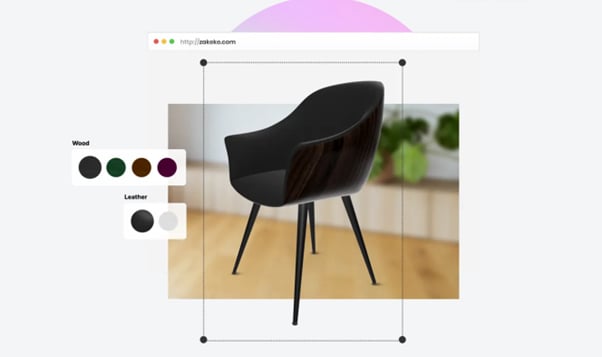Across the American home design industry, 3D has become a must-have – no longer a luxury, but a requirement for delivering engaging and hyper-realistic product experiences online. Customers expect to rotate, zoom, and personalize furniture before they buy. Yet, while most furniture brands already work with high-quality 3D files for internal use or showrooms, bringing those models online remains a major hurdle. Heavy formats like CAD and OBJ don’t translate easily to e-commerce.
Zakeke, in partnership with RapidPipeline, bridges that gap with its new Optimizer Tool: a breakthrough that turns existing 3D models into fast, lightweight, web-ready experiences, without manual work or compromises in quality. With a few clicks, any retailer, no matter their size or technical skills, can finally unlock the full potential of their 3D assets and offer immersive shopping experiences that convert.
How Any Brand Can Dazzle Online
The retail experience once relied on a photograph. Shoppers would study a static image and imagine how a piece might look in their home. Times have changed, and modern buyers crave more. They expect to rotate, customize, and personalize designs long before clicking “buy.” And especially in furniture, where most brands already work with 3D files like CAD or OBJ, the real challenge has been bringing those models online.
Until now, converting technical files into rich, usable 3D visuals meant weeks of outsourcing, rework, and slowdowns. Zakeke’s Optimizer Tool rewrites this laborious script. Design teams can upload their existing models – entire catalogs or collections – and see them automatically converted into web-ready, interactive 3D models (GLB) almost instantly.
Bland and tedious exchanges between 3D specialists and merchants fade into memory. The technology compresses models, preserving gorgeous textures and fine design details in a lightweight format that doesn’t bog down websites. What once took weeks now takes minutes. Even small shops finally have the freedom to present their furniture and décor from every angle, turning viewers into engaged explorers. Every merchant pursuing a unique position in the market finds new ways to capture customer attention and stand out.
Why 3D & AR are Changing the Game for Home Design
Buyers embark on a journey, hoping to see more than just another armchair or table. They crave immersion and the ability to picture a table, lamp, or sofa inside their own homes. Interactive 3D visuals transform home design retail by allowing customers to engage deeply before purchase. And with Zakeke, those same 3D models can be used in Augmented Reality, letting shoppers place pieces directly into their space using just a smartphone.
Marketplace data proves that people spend more time on enhanced product pages and make more confident buying decisions. With fewer returns picking at slim margins across this $394 billion market, retailers welcome the boost. Zakeke empowers every merchant, letting every retailer showcase finishes, enable AR previews, and build immersive digital showrooms. This digital magic, once limited to the largest chains, now becomes routine for anyone bold enough to claim their share of the market. With Zakeke’s experience in high-performance graphics, the Optimizer Tool fiercely defends fidelity and speed. This foundation, built on technology used in gaming and architecture, now powers showrooms dedicated to inspiring customers and building brand loyalty.
Everyone Has a Place in Digital Design
Each leap in accessible technology pushes entire industries forward, and home design finds itself in the middle of such a moment. Desktop publishing once gave neighborhood stores the means to rival national brands in marketing. Sophisticated online platforms then redefined how products are discovered and sold. Now, Zakeke’s Optimizer Tool offers the next leap: enabling furniture makers, designers, and manufacturers to effortlessly turn their existing 3D assets into immersive digital experiences, ready for e-commerce and beyond.
Angelo Coletta, CEO at Zakeke, puts it simply – and his urging lingers in every studio: “Don’t think about 3D as a difficult thing to implement.” Freed from intricate processes, file rework, and technical bottlenecks, teams can finally bring their designs online exactly as intended, with precision, speed, and even Augmented Reality. The future of home design lies in captivating, interactive shopping, where every finish, angle, and material comes to life across digital touchpoints. Who said furniture wasn’t built for e-commerce? With the right experience, even the most refined craftsmanship can shine online, proving that quality and digital don’t just coexist, they amplify each other.






